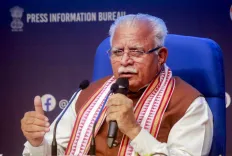How Have Structural Reforms in the Last 11 Years Transformed India’s Macroeconomic Landscape?

Synopsis
Discover how India has undergone a remarkable transformation in its macroeconomic fundamentals through structural reforms over the past eleven years. Finance Minister Nirmala Sitharaman sheds light on the policies that have propelled India to become the fastest-growing major economy.
Key Takeaways
- 11 years of structural reforms have transformed India's economy.
- India's FDI inflows now come from 112 countries.
- Multiple sectors, including MSMEs, have benefited from government initiatives.
- Digital payment systems like UPI have revolutionized transactions.
- The economy has shifted from a twin-deficit issue to a strong financial framework.
New Delhi, June 14 (NationPress) Finance Minister Nirmala Sitharaman highlighted on Saturday that the structural reforms implemented over the past 11 years, guided by Prime Minister Narendra Modi's vision, have fundamentally reshaped India's macroeconomic landscape.
India's position as the fastest-growing major economy is supported by various positive factors and is closely linked to the enhanced balance sheets of critical sectors, including banks, corporations, households, the government, and the external sector, as mentioned by the Finance Minister in a media article.
“The evolution of the Indian economy over the past 11 years—from grappling with a twin-deficit issue to achieving a five-balance sheet advantage—is a result of dedicated policy initiatives under PM Modi’s guidance,” FM Sitharaman shared on the social media platform X.
She noted, “When we assumed office in 2014, our top priority was to revive growth as India was then classified among the ‘Fragile Five’ economies.”
“We launched several structural reforms, such as GST, IBC, and RERA, and during the pandemic years, initiatives like the PLI Scheme and ECLGS were introduced to support creditworthy MSMEs in weathering the Covid crisis. Additionally, infrastructure and asset creation, which had been sidelined for decades, received renewed focus,” the finance minister underscored.
From the digital payment revolution brought about by UPI, achieving transaction volumes exceeding 185 billion in FY25, to the entrepreneurial enthusiasm shown through MUDRA loan disbursements (totaling over Rs 33 lakh crore across 53 crore+ loan accounts), “the last 11 years have demonstrated the potential heights our economy can reach when we blend trust-based governance with systematic regulatory relief and expansion of public goods,” she asserted.
Earlier this month, Commerce and Industry Minister Piyush Goyal remarked that India's FDI inflows now come from 112 countries, up from 89 in 2013-14, highlighting the nation’s growing global appeal.
India's FDI success story encapsulates not just remarkable figures but also epitomizes visionary reforms, policy transparency, and the global community's faith in the country’s economic prospects, he added.









